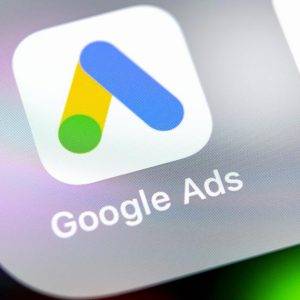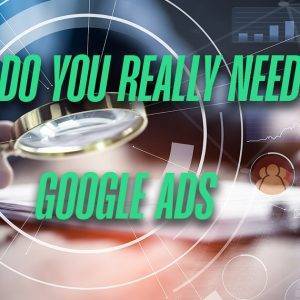Do Google Ads work?

Filters
Results
The internet is rife with advertising. Ads appear before YouTube videos, in the middle of Facebook feeds, and on top of Google results. Google Ads–formerly Google AdWords–are the ads that appear before the normal results. They’re a quick way to get to spot one on Google quickly. But does advertising on Google Ads really work?
For many businesses, yes, it does. However, success depends on many factors, such as how much time you invest into creating the ads, the quality of the website itself, and of course, advertising budget. Even on a smaller budget, Google Ads can work–as long as they’re done right.
The different goals of advertising on Google Ads
Ask most businesses what their goal for Google Ads is, and they’ll answer with “Get more customers”. And Google Ads can help with that. But the final sale or new customer is only one stage of the Buyer’s Journey. There are several different types of goals in Google Ads with the main ones being getting website visits, getting leads, and making sales.
Getting website visits through Google Ads
Not all sites need or even want sales or customers. For some, the goal is to raise awareness. Think of non-profits like charities, who want people to be aware of a specific issue. They may not have anything to sell. They may not accept donations. For these types of sites, the goal is to educate customers, and you’ll pay Google Ads for each click on your ad that leads to your website, with the average across all industries being about $3.80 NZD per click.
One study showed that educated customers are over 130% more likely to do business with a company. And the more expensive the product or service, the more likely someone is to do thorough research before making a decision. Using the website traffic goal can help get people to your website–then it’s up to you to have the right information on the site to keep them interested. If your site is small and simple and you don’t add articles or updates regularly, the website traffic goal may not be right for you.
Since costs per click (CPC) are relatively low, they’re a fantastic option for a smaller budget. Sometimes, people simply don’t know that you’re an option. By showing up in Google for the right keywords, they can find you, learn about you, and maybe decide to do business with you.
Getting leads through Google Ads
When you can’t make sales directly through the website or are looking to get leads, advertising on Google Ads can help you get them. Google Ads can help by having you pay for each conversion. Standard options for conversions include calls made by clicking the call button on an ad or filling out a contact form. You can also set them for custom actions–like if someone visits a thank you page–but these require adding some code to your site manually or by using Google Tag Manager. Naturally, the cost for a conversion action is much higher than the cost per click, currently at around $70 NZD per conversion.
The benefit of using this kind of goal and bidding strategy is that you can see how many leads come directly from ads. If you sell a service that profits you $500 and ends up costing $50 to get a customer, then you’ve gotten yourself a pretty good deal… Especially if they become a regular!
Getting Sales through Google Ads
If you have the ability for people to buy products directly on your website, you can create Google Ads to target getting purchases. Using this goal is great because it’s easy to track if your ads are making you money. However, to work properly it requires extra setup and adding code to your website to track purchases. Technically, a sale is considered a conversion action by Google Ads. This means across all industries, the average is $70 NZD.
For smaller, less expensive products however, this amount can be much lower. The cost per action on apparel, for example, is around $15 NZD. On the opposite end, for high-tech industries, it’s over $180 NZD.
How do you get your cost per click or cost per action lower?
If those costs seem like they’re a bit on the high side, that’s because they are. Properly made and optimised ads can be much cheaper and deliver better results. But these require a bigger time investment both for the ads and for the website itself.
Google decides how much an ad costs to run based on Quality Score. This quality score is a scale of 1-10 and includes the relevance of the keywords, the design and writing on the ad itself, and the relevance of the page the ad leads to. Using the keyword “best” and with an ad that just says “We’re the best” and a page with only “Call us now” will be closer to a 1. Well-written ads leading to an optimised page clearly related to the search term can get you a 10. And the difference in cost for quality ads isn’t just a little bit either. A 10 ad can cost half as much of a 4 ad and several times less than a 1.
Real-world examples of successful Google Ads
At Back9 Creative, we have several clients who are consistently outperforming others in their industry with better results at a lower cost. Some of these include:
- A retail store with a cost per click of 20 cents NZD–less than 1/10 of the average across all industries and less than 1/5 of the average for other e-commerce sites.
- A property maintenance company with $34 NZD cost per action — less than half of the Consumer Services average of $84 NZD.
- A speciality service B2B business with under $2 NZD cost per click and $60 NZD cost per action — with average B2B at $160 NZD per action and $4.67 NZD per click.
So how are these costs so much lower than average? First, we are certified in Google Ads, which involves taking courses created by Google and passing the certification exam. We also aim to maximise Quality Score through a combination of creating professional ads with excellent website experiences. Finally, we update ads, campaigns and keywords regularly to maximise effectiveness. If you’re looking to advertise on Google Ads successfully, get in touch with us today and see what Google Ads can do for your business.







